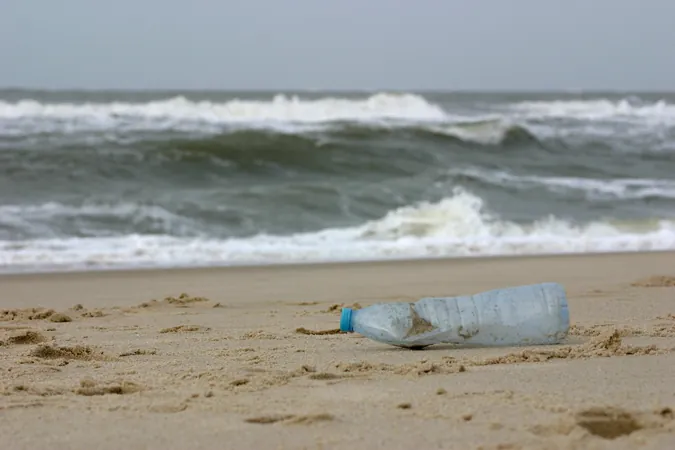
Citizen Scientists Unveil Shocking Levels of Microplastics Across German Coastline
2024-09-25
Author: Rajesh
Introduction
In an alarming revelation, citizen scientists have joined forces with researchers from the Alfred Wegener Institute to uncover widespread microplastic pollution along the entire German coastline. Their groundbreaking project, dubbed "Microplastic Detectives," harnessed the power of citizen involvement to gather data that now paints a clear picture of plastic contamination across both the North Sea and Baltic coasts.
The Scope of the Problem
As global plastic production surges—predicted to nearly triple by 2060—plastic waste has infiltrated every corner of our environment, raising urgent concerns about its impact on ecosystems. The German coast is no exception, where microplastics, defined as plastic particles smaller than or equal to five millimeters, have found their way into our waters and onto our beaches.
Previous Research Limitations
Until now, most research on microplastics in Germany has been limited to localized areas, leaving gaps in understanding the full extent of pollution. Thanks to the dedication of countless citizen scientists, the latest study compiled a staggering dataset for analysis—marking a pivotal moment in environmental research. The findings were recently published in the journal *Frontiers in Environmental Science*.
Data Collection and Analysis
"We have combined a total of 1,139 comparable samples into one large dataset, covering more geographic ground than ever before," stated Dr. Melanie Bergmann, a biologist at AWI who co-authored the study. From 71 diverse sampling locations, the team collected 2.2 metric tons of sand, meticulously analyzing it for microplastic content.
Findings of the Study
What emerged from the analysis is both surprising and concerning. Plastic pollution was detected on 52 out of the 71 tested beaches, yet the volume of larger microplastic pieces was found to be lower than previously reported in other studies. "If we had also analyzed smaller microplastic particles, our findings would likely indicate much higher concentrations," warned Dr. Bruno Walther, the lead author and former AWI researcher now at Heinrich Heine University Düsseldorf.
Volume of Microplastics
The analysis disclosed that of the 1,139 samples, 177 contained 260 plastic particles, translating into an average of about four plastic particles per square meter. While this may seem minimal, extrapolating this data suggests that a 10-hectare beach could harbor upward of 400,000 plastic particles. The alarming variance in pollution levels from site to site underlines the need for systematic monitoring.
Policy Implications
With politicians facing intense pressure to act, it's critical for future policies to be informed by robust scientific data. The study serves as a vital tool for evaluating the effectiveness of existing regulations and gauging the need for more stringent measures to combat plastic waste. Legislative efforts in north-west Europe, for instance, seemingly reduced the presence of plastic bags on the seafloor over the last quarter-century.
The Role of Citizen Scientists
The "Microplastic Detectives" initiative exemplifies the potential of citizen engagement in environmental science. "We were overwhelmed by the enthusiasm and commitment displayed by citizen scientists who dedicated hours to this cause. Our sincere thanks go out to them," expressed Walther.
Conclusion
As the urgent conversation around plastic pollution intensifies, the study underlines the importance of community involvement and its potential to drive change. "The ideal outcome would be to create a long-term monitoring framework, utilizing citizen scientists as crucial players in tackling the microplastic crisis," Dr. Bergmann added.
Final Thoughts
Ultimately, this pioneering research could provide a critical blueprint for battling plastic pollution, safeguarding coastal environments, and protecting tourism and human health—an endeavor that has never been more vital. As our oceans continue to suffer from plastic waste, the time to take action is now!




 Brasil (PT)
Brasil (PT)
 Canada (EN)
Canada (EN)
 Chile (ES)
Chile (ES)
 España (ES)
España (ES)
 France (FR)
France (FR)
 Hong Kong (EN)
Hong Kong (EN)
 Italia (IT)
Italia (IT)
 日本 (JA)
日本 (JA)
 Magyarország (HU)
Magyarország (HU)
 Norge (NO)
Norge (NO)
 Polska (PL)
Polska (PL)
 Schweiz (DE)
Schweiz (DE)
 Singapore (EN)
Singapore (EN)
 Sverige (SV)
Sverige (SV)
 Suomi (FI)
Suomi (FI)
 Türkiye (TR)
Türkiye (TR)